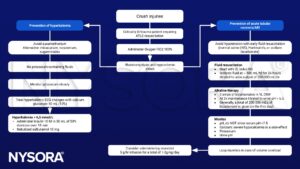Learning objectives
- The course and symptoms of crush injuries/crush syndrome
- Anesthetic management of crush injuries
Definition and mechanisms
- Crush injuries are the result of physical trauma from prolonged compression of the torso, limb(s), or other parts of the body
- Muscles are grossly swollen, hard, cold, insensitive, and necrotic
- Extended entrapment with compression may cause:
- Crush syndrome
- Traumatic rhabdomyolysis
- Compartment syndrome
- Rhabdomyolysis is characterized by skeletal muscle disintegration and the release of myoglobin and other proteins and electrolytes into the circulation:
- Magnesium, phosphate, acids, creatine phosphokinase, and lactate dehydrogenase
- ↑ Potassium → cardiac arrhythmias
- Sodium, calcium, and fluids → raised muscle volume and tension
- NO → muscle vasodilatation and aggravation of hypotension
- Myoglobuniuria and hypovolemia may lead to AKI
-
- Tubular obstruction
- Direct and ischemic tubular injury
- Intrarenal vasoconstriction
- DIC may rarely happen with severe rhabdomyolysis
- Ultimately, patients go into shock affecting respiratory gas exchange due to lung edema
Signs and symptoms
- Petechiae
- Blisters
- Muscle bruising
- Superficial injuries
- Myalgia
- Muscle paralysis
- Sensory deficit
- Fever
- Cardiac arrhythmia
- Pneumonia
- ‘Tea or cola’ colored urine
- Oliguria
- Renal failure
- Nausea
- Vomiting
- Agitation
- Delirium
Management

D5W, dextrose 5% in water
Suggested reading
- Pollard BJ, Kitchen, G. Handbook of Clinical Anaesthesia. Fourth Edition. CRC Press. 2018. 978-1-4987-6289-2.
- James Williams, MBBCh FRCA FFICM, Chris Thorpe, MBBS FRCA FFICM, Rhabdomyolysis, Continuing Education in Anaesthesia Critical Care & Pain, Volume 14, Issue 4, August 2014, Pages 163–166.
- Rajagopalan S. Crush Injuries and the Crush Syndrome. Med J Armed Forces India. 2010;66(4):317-320.
We would love to hear from you. If you should detect any errors, email us customerservice@nysora.com







